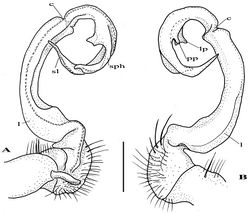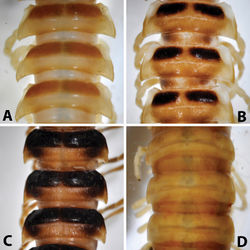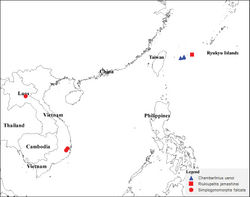Simplogonomorpha falcata
| Notice: | This page is derived from the original publication listed below, whose author(s) should always be credited. Further contributors may edit and improve the content of this page and, consequently, need to be credited as well (see page history). Any assessment of factual correctness requires a careful review of the original article as well as of subsequent contributions.
If you are uncertain whether your planned contribution is correct or not, we suggest that you use the associated discussion page instead of editing the page directly. This page should be cited as follows (rationale):
Citation formats to copy and paste
BibTeX: @article{Nguyen2011ZooKeys156, RIS/ Endnote: TY - JOUR Wikipedia/ Citizendium: <ref name="Nguyen2011ZooKeys156">{{Citation See also the citation download page at the journal. |
Ordo: Polydesmida
Familia: Paradoxosomatidae
Genus: Simplogonomorpha
Name
Simplogonomorpha falcata (Attems, 1953) comb. n. – Wikispecies link – Pensoft Profile
- Haplogonosoma falcatum Attems, 1953: Mémoires du Muséum National d’Histoire Naturelle, Paris {N. S., Sér. A, Zool.}, 5(3): 177, figs 81–82.
- Riukiupeltis falcatus:– Jeekel 1968[1]: On the classification and geographical distribution of the family Paradoxosomatidae (Diplopoda, Polydesmida), Nederlandse Entomologische Vereiniging: 62.
Material studied
3 males, 2 females, (IEBR-166), Vietnam, Lam Dong prov., Bi Doup-Nui Ba National Park, corn field, 1400m a.s.l., pitfall traps, 2–9 April 2008, leg. Anh. D. Nguyen; 1 male, 1 female, 1 juvenile, (IEBR-167), same locality, grasslands, 1400m a.s.l., pitfall traps, 2–9 April 2008, leg. Anh. D. Nguyen; 1 female, (IEBR-168), same locality, bushes near stream, 1400m a.s.l., pitfall traps, 25 April 2008, leg. Anh. D. Nguyen; 4 males, 2 females, (IEBR-169), same locality, evergreen forest, 1800m a.s.l., 25 March–23 April 2008, leg. Anh. D. Nguyen;1 male (IEBR-125), Vietnam, Khanh Hoa Prov., Hon Ba Mts., 1300–1500m a.s.l., primary forest, 15–24 April 2006, leg. Anh. D. Nguyen; 1 male, 1 female, (HNHM), same data as sample IEBR-125.
Description
Head: yellowish-brown to blackish brown, a slightly paler toward labrum. Epicranial suture distinct, obviously deep.
Antennae: short and stout, yellowish-brown to blackish brown. Length of antennomere 2 subequal to that of antennomere 3, 4 or 5. Antennomere 6 shorter and claviform.
Body: yellowish-brown to blackish brown on terga, paler on paraterga and pleura. Body parallel-sided on somites 5–17, thereafter gradually tapering.
Surface of metaterga general fine in posterior part, but with small oblique or longitudinal rugulose in anteriormost part. Stricture dividing pro- and metazona deep, obvious and beaded. Prozona surface shagreened with fine microgranulation.
Transverse sulcus on metaterga starting from somite 5 and more evident on subsequent somites. Metaterga with a row of 2+2 setae in pre-sulcus part. Axial line vague.
Paraterga not well-developed, small, look like small keels in poreless segments, but more developed in pore-bearing somites. Ozopore located on lateral side, near tip of angular paraterga of segments 5, 7, 9–10, 12–13 and 15–19.
Pleura shagreened with fine microgranulation. Pleurosternal carinae rather well-developed in anteriormost segments, gradually decreasing posteriorly.
Epiproct truncated and curved down ventrad, with 4 strong setae on tip. Anal valves sub-semicircular with 1+1 long setae, and a deep emargination inbetween. Hypoproct trapeziform, with 1+1 setae.
Legs: yellow to yellowish brown, short and stout. Tarsal brushes present until legpair 10, sparsely until legpair 16, and completely missing thereafter.
Sterna: normal, sparsely setose, with two large tubercles between coxae 4.
Male gonopod: very simple, hook-like in dorsal view. Coxa subcylindrical, distoventral part sparsely setose. Prefemoral part usually densely setose, with evident demarcation from both femorite and coxa. Femorite slender, much longer than coxite and a little curved down distally, separated from postfemoral part by an evident, subtransverse sulcus laterally and mesally. Solenomere simple, strongly curved down, slender, and tapering at tip. Tibiotarsus totally absent.
Prostatic groove runs mesally along femorite, distolaterad, and turns to lateral side, then running mesally, and ending at tip of solenomere.
Distribution
Vietnam, Lam Dong province, Bi Doup-Nui Ba National Park; Khanh Hoa province, Hon Ba Mountain; Laos PDR, Xieng Khoang
Remarks
New material does not much differ from Attems’s description. Only minor difference is the presence of two separate cones between coxae 4 instead of only one small conal process in Attems’s description. Recently, Chen et al. (2011)[2] also published an illustration of gonopods of Haplogonosoma falcatum collected from the same locality, BiDoup National Park, Vietnam. Our material here fits well with their unevaluated illustration.
Key to representatives to all three genera (based on male characters) In the key above, Riukiupeltis and Simplogonomorpha are represented by only one species each (jamashinai and falcata, respectively). Chamberlinius, on the other hand, includes at present five species: Chamberlinius hualienensis, Chamberlinius piceofasciatus, Chamberlinius pessior, Chamberlinius sublaevus (all keyed already by Chen et al. 2011[2]), and Chamberlinius uenoi, as added here.Taxon Treatment
- Nguyen, A; Korsós, Z; 2011: A revision of the millipede genus Riukiupeltis Verhoeff, 1939 (Diplopoda, Polydesmida, Paradoxosomatidae), with comments on the status of related species ZooKeys, 156: 25-40. doi
Other References
- ↑ Jeekel C (1968) On the classification and geographical distribution of the family Paradoxosomatidae (Diplopoda, Polydesmida). Nederlandse Entomologische Vereiniging 62, 162 pp.
- ↑ 2.0 2.1 Chen C, Golovatch S, Chang H, Chen S (2011) Revision of the Taiwanese millipede genus Chamberlinius Wang, 1956, with descriptions of two new species and a reclassification of the tribe Chamberlinini (Diplopoda, Polydesmida, Paradoxosomatidae). ZooKeys 98: 1-27. doi: 10.3897/zookeys.98.1183
Images
|





